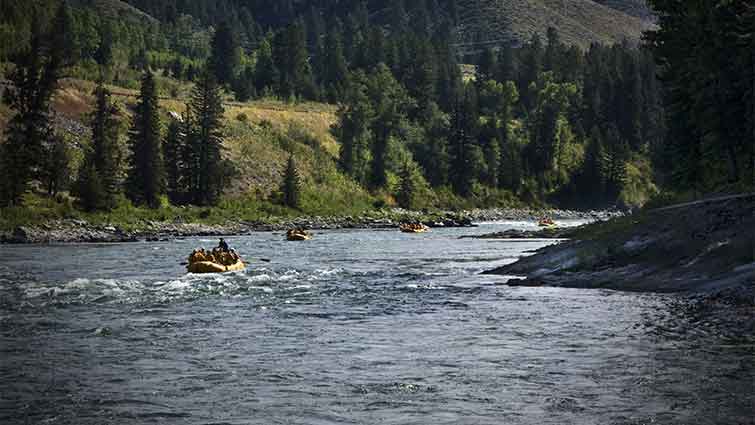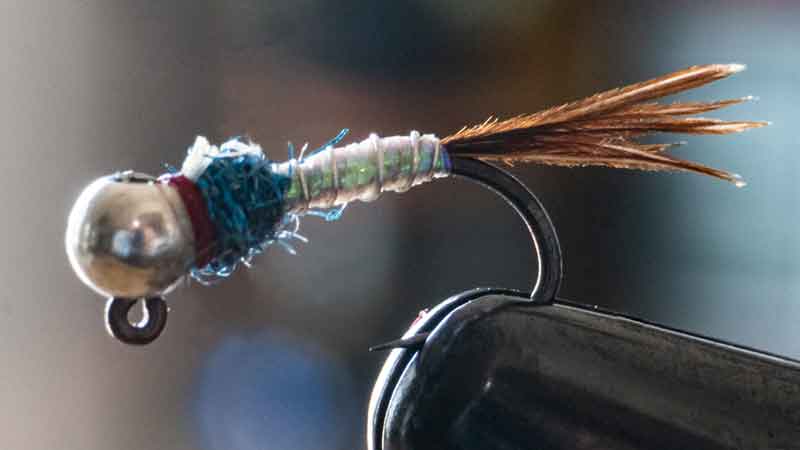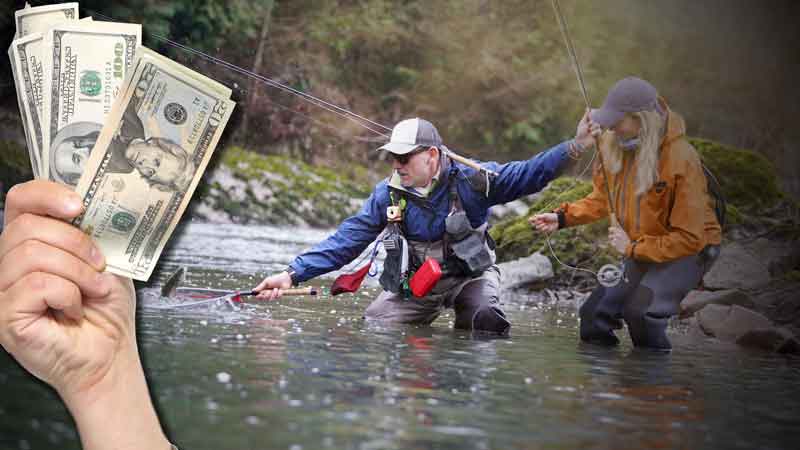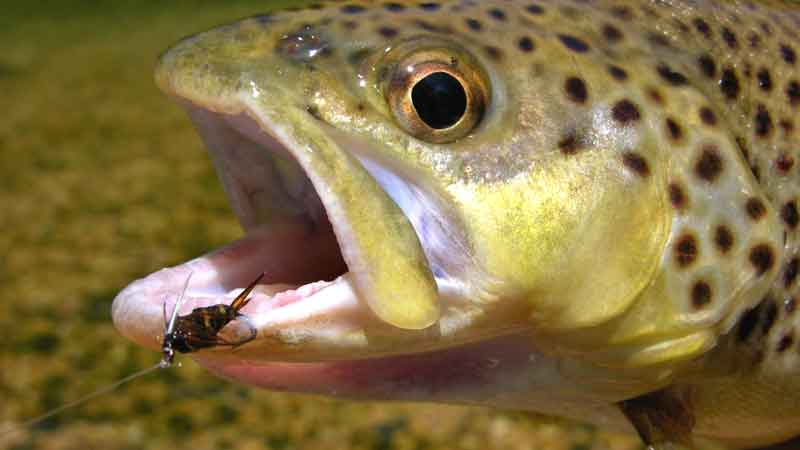The size of your hook influences how well your fly mimics the natural prey of your target fish and how it behaves in the water. Too large, and your fly may appear unnatural or scare away wary fish; too small, and it might not stay securely hooked during a strike. Additionally, different types of flies—whether nymphs, dry flies, or streamers—require different hook sizes to perform optimally. This guide will delve into the nuances of fly fishing hook sizes, offering detailed insights into selecting the right hook for various fly types and fishing conditions.

We’ll explore the range of hook sizes available, from the tiniest midge patterns to the robust hooks used in saltwater fishing. You’ll learn how to match your hook size to the specific species you’re targeting, your fishing environment, and the natural insects or baitfish present. Whether you're wading through a pristine mountain stream in search of trout or casting into the surf for saltwater giants, this comprehensive guide will equip you with the knowledge to choose the perfect hook size for any situation.
What sizes do hooks come in for fly fishing?
Fly fishing hooks come in a wide range of sizes, typically denoted by numbers. The sizes range from very small, like size 28, to large, like size 2, with the sizes inversely proportional to their numbers – the smaller the number, the larger the hook. For example, a size 2 hook is significantly larger than a size 24 hook.
Small Hooks (Sizes 18-28)
Small hooks are used for tiny flies, such as midges and very small dry flies. These sizes are crucial for fishing in clear, calm waters where fish are particularly cautious and feed on small insects. Examples of flies tied on small hooks include:
- Midges: Often tied on sizes 20-28, these tiny flies are essential for winter fishing or when targeting picky trout feeding on microscopic insects.
- Tiny Dry Flies: Patterns like the Trico spinner are tied on sizes 20-24, mimicking small adult mayflies.

Medium Hooks (Sizes 10-18)
Medium hooks are versatile and commonly used for nymphs, standard dry flies, and some streamers. They are the bread and butter of many fly boxes because they cover various insect sizes and types.
- Standard Dry Flies: Popular patterns like the Adams or Elk Hair Caddis are typically tied on sizes 12-16.
- Nymphs: Hare’s Ear and Pheasant Tail nymphs are usually tied on sizes 14-16, imitating various aquatic insects.
Large Hooks (Sizes 2-4/0)
Large hooks are ideal for streamers, saltwater flies, and large nymphs. They are designed to mimic bigger prey like baitfish and leeches, which are targeted by larger fish species.
- Streamers: Patterns like the Woolly Bugger or Clouser Minnow are tied on sizes 2-6, perfect for imitating minnows and other small fish.
- Saltwater Flies: Flies such as the Deceiver or Crazy Charlie are tied on sizes 2-1/0, designed to attract species like bonefish and tarpon.

How to choose the best hook size
Choosing the best hook size depends on several factors, including the type of fish you are targeting, the type of fly you are using, and the water conditions. Here are some tips to help you make the best choice:

Match the Hatch
Matching the hatch involves observing the size and type of natural insects or baitfish in the water and selecting a fly that mimics them. This concept is fundamental in fly fishing, as fish are more likely to be enticed by something that looks like their natural food source.
- Observation: Spend time watching the water to see what insects are present. Note their size and behavior.
- Seasonal Changes: Insects vary by season, so adjust your hook sizes and fly patterns accordingly. Spring and summer might see larger insects, while winter can bring smaller midges.

Fish Species
Different fish species have varying feeding behaviors and preferred prey sizes. Understanding your target species can help you choose the appropriate hook size.
- Trout: Often feed on small to medium-sized insects, making hook sizes 12-20 suitable for most trout flies.
- Bass: Larger predators that can handle bigger prey, so hook sizes 4-10 are often used for bass flies.
- Saltwater Species: Fish like tarpon and redfish require larger hooks, typically ranging from size 2 to 3/0.

Water Clarity
Water clarity can influence hook size choice. In clear water, fish are more cautious and may shy away from larger, more visible hooks.
- Clear Water: Smaller hooks (sizes 18-24) and delicate presentations are often more effective.
- Murky Water: Larger hooks (sizes 10-14) can be used as fish rely more on their lateral line to detect prey rather than sight alone.

Best size hook for nymph flies
Nymph flies, which imitate the immature stages of aquatic insects, are a staple in fly fishing. The best hook sizes for nymph flies usually range from size 10 to size 18. This range covers a variety of nymphs, from larger stoneflies to smaller mayflies and caddisflies.
Size 10-12
These sizes are ideal for larger nymph patterns, such as stoneflies. Stonefly nymphs are substantial insects, often found in fast-moving water, making them a favorite food source for trout.
- Patterns: Pat's Rubber Legs, Kaufmann’s Stonefly.
- Situations: Early spring or in rivers with significant stonefly populations.
Size 14-16
These sizes are commonly used for mayfly and caddisfly nymphs. They represent a wide array of aquatic insects that trout feed on throughout the year.
- Patterns: Pheasant Tail, Hare’s Ear, Prince Nymph.
- Situations: All-year-round, especially effective in streams and rivers with diverse insect life.
Size 18 - 22
These are perfect for small nymph patterns such as midges and tiny mayfly nymphs. Small nymphs can be critical when fish are feeding selectively on smaller prey.
- Patterns: Zebra Midge, Black Beauty.
- Situations: Late winter and early spring, or whenever small insects are prevalent.

Best size hook for dry flies
Dry flies are designed to float on the water's surface, imitating adult insects. The best hook sizes for dry flies typically fall between size 12 and size 24.
Size 12-14
Suitable for larger dry flies like hoppers and larger mayflies. These sizes are often used during the height of summer when terrestrial insects are more common.
- Patterns: Stimulator, Parachute Adams.
- Situations: Summer months, when larger insects like grasshoppers and larger mayflies are present.
Size 16-18
Ideal for standard dry fly patterns, including many mayflies and caddisflies. These sizes are the most versatile and commonly used in dry fly fishing.
- Patterns: Elk Hair Caddis, Comparadun, Blue Wing Olive.
- Situations: Throughout the fishing season, especially effective during mayfly and caddis hatches.
Size 20-24
Used for very small dry flies, such as midges and tiny mayflies. These sizes are critical for matching the hatch during specific times of the year when small insects dominate.
- Patterns: Griffith’s Gnat, Trico Spinner.
- Situations: Late fall and winter, or when fishing slow, clear water with selective fish.

Best size hook for Euro flies
Euro nymphing has gained popularity due to its effectiveness in catching fish. Euro flies, often tied on jig hooks, benefit from sizes that range from 12 to 18.
Size 12-14
Good for larger Euro nymphs, including some stoneflies and caddisfly larvae. These sizes are effective for imitating bigger prey that fish target in faster currents.
- Patterns: Perdigon, Frenchie.
- Situations: Fast-moving water, where a heavier fly is needed to get down quickly.
Size 16-18
Standard for most Euro nymph patterns, providing a good balance between hook size and natural presentation. These sizes are versatile and can imitate a wide range of nymphs.
- Patterns: Rainbow Warrior, Pheasant Tail Jig.
- Situations: All-year-round, especially in rivers with diverse insect populations.

Best size hook for streamers
Streamers are used to imitate baitfish, leeches, and other larger prey items. The best hook sizes for streamers typically range from size 2 to size 10.
Size 2-4
Used for very large streamers targeting big fish. These sizes are effective when targeting aggressive species like pike or large trout.
- Patterns: Muddler Minnow, Clouser Minnow.
- Situations: Larger rivers or lakes, where bigger prey is common.
Size 6-8
Standard for most streamer patterns, providing versatility and effectiveness. These sizes are the workhorses of streamer fishing, effective in various water types.
- Patterns: Woolly Bugger, Zonker.
- Situations: Rivers, lakes, and ponds, where medium-sized baitfish are prevalent.
Size 10-16
Suitable for smaller streamers or when fish are less aggressive. These sizes can be useful when fish are more cautious or when imitating smaller prey.
- Patterns: Matuka, Black Ghost.
- Situations: Smaller streams or during periods of lower fish activity.

Best size hook for saltwater flies
Saltwater fly fishing requires hooks that can handle larger and stronger fish. The best hook sizes for saltwater flies range from size 2 to size 2/0.
Size 2
Used for smaller saltwater flies targeting species like bonefish. These sizes are effective in clear, shallow waters where fish can be selective.
- Patterns: Crazy Charlie, Gotcha.
- Situations: Flats fishing, where bonefish and similar species are found.
Size 1-1/0
Ideal for medium-sized saltwater flies, effective for species like redfish and snook. These sizes offer a balance of strength and stealth, making them versatile for various saltwater conditions.
- Patterns: Clouser Minnow, Redfish Toad.
- Situations: Estuaries and mangroves, where medium-sized predators are hunting.
Size 2/0-4/0
Suitable for large saltwater flies targeting big species like tarpon and giant trevally. These sizes are built to handle the power and speed of larger saltwater fish.
- Patterns: Tarpon Toad, Deceiver.
- Situations: Offshore and deep flats, where large predators roam.
Choosing the right hook size is crucial for successful fly fishing. By understanding the various hook sizes and their appropriate applications, you can enhance your chances of a productive day on the water. Whether you're targeting trout in a mountain stream or chasing tarpon in the salt flats, the right hook size will help you present your fly in the most natural and enticing way.
Remember, fly fishing is as much about observation and adaptation as it is about skill and technique. Pay attention to the conditions and the fish's behavior, and adjust your hook size and fly selection accordingly.
Frequently Asked Questions

How do you tell the size of a fly fishing hook?
Fly fishing hook sizes are identified by numbers, with smaller numbers indicating larger hooks and larger numbers indicating smaller hooks. To tell the size of a hook, look at the number typically stamped on the packaging or the hook itself. The numbering system can be a bit counterintuitive initially, but with practice, you'll get a feel for which sizes are appropriate for different types of flies and fishing situations.
Is a size 12 hook bigger than a size 10?
No, a size 12 hook is actually smaller than a size 10 hook. In fly fishing, the numbering system for hooks is inverse; as the number increases, the hook size decreases. This means that a size 10 hook is larger than a size 12 hook.
What's the best size hook for trout?
The best size hook for trout depends on the type of fly you are using and the specific conditions you are fishing in. Generally, sizes 12 to 18 are popular for trout fishing.
- Nymphs: Size 14-16
- Dry Flies: Size 16-18
- Streamers: Size 6-10
These sizes provide a good balance for presenting flies that match the natural prey of trout.
What is the order of fishing hook sizes?
Fishing hook sizes are ordered inversely by number; as the number increases, the size of the hook decreases. Here is a general order of hook sizes from largest to smallest:
- 4/0, 3/0, 2/0, 1/0, 1, 2, 4, 6, 8, 10, 12, 14, 16, 18, 20, 22, 24, 26, 28
Hooks larger than size 1 are often denoted with an "aught" (e.g., 1/0, 2/0), with larger numbers indicating larger hooks.
What size hook is best for fly fishing?
The best size hook for fly fishing varies depending on the type of fly and the target species. Here are some general recommendations:
- Nymph Flies: Size 10-18
- Dry Flies: Size 12-24
- Euro Nymph Flies: Size 12-18
- Streamers: Size 2-10
- Saltwater Flies: Size 2-2/0
These sizes provide a versatile range that covers most fly fishing scenarios.
What are actual fly hook sizes?
Actual fly hook sizes refer to the physical dimensions of the hook, including the gap (the distance between the shank and the point) and the length of the shank. Here are some examples:
- Size 2 Hook: Larger gap and longer shank, suitable for big streamers and saltwater flies.
- Size 12 Hook: Medium gap and shank, commonly used for nymphs and dry flies.
- Size 24 Hook: Very small gap and short shank, used for tiny dry flies and midges.
The physical size of the hook determines how the fly will look and behave in the water, impacting its effectiveness in attracting fish.
Conclusion
Choosing the right hook size is crucial for successful fly fishing. Understanding the various hook sizes and their appropriate applications can enhance your chances of a productive day on the water. Whether you're targeting trout in a mountain stream or chasing tarpon in the salt flats, the right hook size will help you present your fly most naturally and enticingly.





